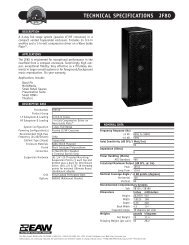
#EAW DX810 DIGITAL SIGNAL PROCESSOR SERIES#
“That ceiling is projected onto by a series of seven projectors that are hidden in a central 8- by 8- by 8-foot square structure in the middle of the floor. “The hemispherical perforated ceiling is also a projection screen,” says Michael Dobbs, project architect from SmithGroup.

Because no such lens existed, SEOS, a supplier of visual display systems, was forced to develop a complex system consisting of seven projectors hidden inside the center structure, six projectors that project around the dome, and one that shoots straight up to fill the dome’s center. The original idea was to position a single projector with a fish-eye lens in the center. The dome screen, which emphasizes the importance of the sky and nature to American Indian cultures, required a projection system that posed design challenges. Its intimate circular space features three projection surfaces: a 40-foot, 360-degree dome surrounding the audience, a vacuum-formed faux rock centered in the space, and four waffle cloth screens replicating Native textile art. The theater, a wood-lined space reminiscent of southwest kivas and earth lodges, was inspired by traditional Native American architecture and storytelling, yet it houses very sophisticated technology. SPL needed to redesign the AV systems before they could be installed and integrated into the building’s infrastructure. SPL Integrated Solutions was hired as the AV systems integrator about a year before the opening of the theater, by which time the AV design was about 2 years old. The design of the Lelawi Theater by Batwin + Robin, Hilferty & Associates, and Jones & Jones Architect began three years before the museum opened. Anchoring this soaring space is an information desk and, above it, the Welcome Wall, a 20-foot-long thin-laminate, rear-projection screen running a continuous loop of AV programming, welcoming visitors in 150 Native languages.įrom the Potomac Area, visitors are ushered to the fourth floor, where the exhibit really begins in the 120-seat Lelawi Theater, with a 13-minute introductory film about the exhibits from a Native American perspective. Visitors enter from the entrance area, a 120-foot-tall circular atrium with a central wooden floor for dance performances, a domed skylight, and a staircase that curls upward through four floors. “I would say about 85 percent of the hardware that delivers the programming to these display units is all centralized in our network control center.” “There are more than 100 different AV programs in the exhibits and public areas of the building,” says Kathy Suter, the museum’s Media Coordinator. To showcase the stories, objects, and lives of Native Americans, the museum staff and designers chose to incorporate state-of-the-art technology, wiring the building with more than 400 multiple communications systems outlets controlled from a single network operations center in the basement of the building. Because the purpose of the museum is to offer a glimpse at the complexities of native cultures, Native Americans took the lead in all phases of its planning, design, and construction, imbuing even the smallest details of the exhibits with meaning and symbolism. Inside the museum, some 800,000 objects help illuminate 10,000 years of history and more than 1,000 indigenous cultures in the Western Hemisphere.



The newest Smithsonian on the National Mall is the National Museum of the American Indian (NMAI), an imaginative melding of traditional artifacts and cutting-edge technology that brings Native American cultures to life.


 0 kommentar(er)
0 kommentar(er)
